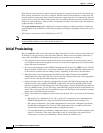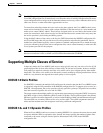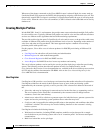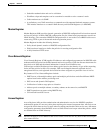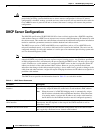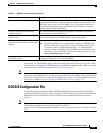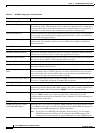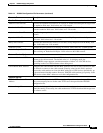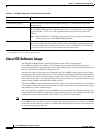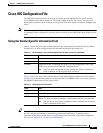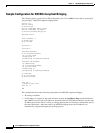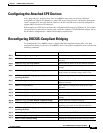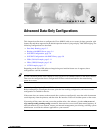
2-4
Cisco uBR924 Software Configuration Guide
OL-0337-05 (8/2002)
Chapter 2 DOCSIS-Bridging Configuration
DOCSIS Configuration File
Table 2-2 DOCSIS Configuration File Parameters
Parameter
1
Description
Radio Frequency Parameters
Downstream Frequency Specifies the center frequency (in multiples of 62500 Hz) for the downstream channel to
be used by the router. (This parameter does not need to be specified in the configuration
file because the router will scan the downstream for available frequencies, but typically it
is specified to ensure that the router conforms to the provider’s channel plan.)
Upstream Channel ID Specifies channel ID for the upstream channel to be used by the router. (This parameter
does not need to be specified in the configuration file because it can be set dynamically
by the CMTS during provisioning.)
Network Access Configuration Determines whether CPE devices attached to the cable modem are allowed access to the
cable network. The default is to allow access for CPE devices (which is required for
normal operations).
Class of Service
Class of Service ID Specifies the ID for this class of service (1–16).
Maximum Downstream Rate Specifies the maximum downstream data rate (in bits/sec) allowed for traffic associated
with this class of service. (This is a limit, not a guarantee of service.)
Maximum Upstream Rate Specifies the maximum upstream data rate (in bits/sec) allowed for traffic associated with
this class of service. (This is a limit, not a guarantee of service.)
Upstream Channel Priority Specifies the priority for upstream traffic (0–7, where 7 is highest priority).
Minimum Upstream Rate Specifies the minimum upstream data rate (in bits/sec) that is guaranteed for traffic
associated with this class of service.
Maximum Upstream Channel
Burst
Specifies the maximum size of burst traffic to be allowed on this upstream channel. The
size is specified in bytes, 0–65535, where 0 is no limit. If this field is set to a non-zero
value, it should be set to at least 1800 so that it is greater than the maximum Ethernet
frame size of 1518 plus the associated packet overhead).
Class of Service Privacy Enable Specifies whether BPI encryption should be enabled on traffic associated with this class
of service (1 enables BPI encryption, 0 disables BPI encryption).
Vendor Specific Options
Vendor ID The three-byte Organization Unique Identifier for the vendor, which is also usually the
first three bytes of the cable modem’s MAC address. This value is usually expressed as a
hexadecimal number. This field should be “00000C” for Cisco Systems routers.
Vendor-Specific Options Contains any arbitrary values that are defined by the manufacturer of the cable modem.
The Cisco uBR924 cable access router uses this field to identify the Cisco IOS
configuration file that should be downloaded (if any). Arbitrary Cisco IOS commands can
also be specified in this field.
SNMP Management
SNMP Write-Access Control
and SNMP MIB Objects
Allows the service provider to set arbitrary SNMP attributes on the cable modem. For the
Cisco uBR924 router, these two fields are typically used to enable SNMP management of
the router because SNMP management is disabled by default.
Note If using the Cisco DOCSIS Cable Modem Configurator tool, you can enable
SNMP management by filling in the IP address for the SNMP manager. The
Configurator tool then prepares the proper MIB objects to enable SNMP access.



